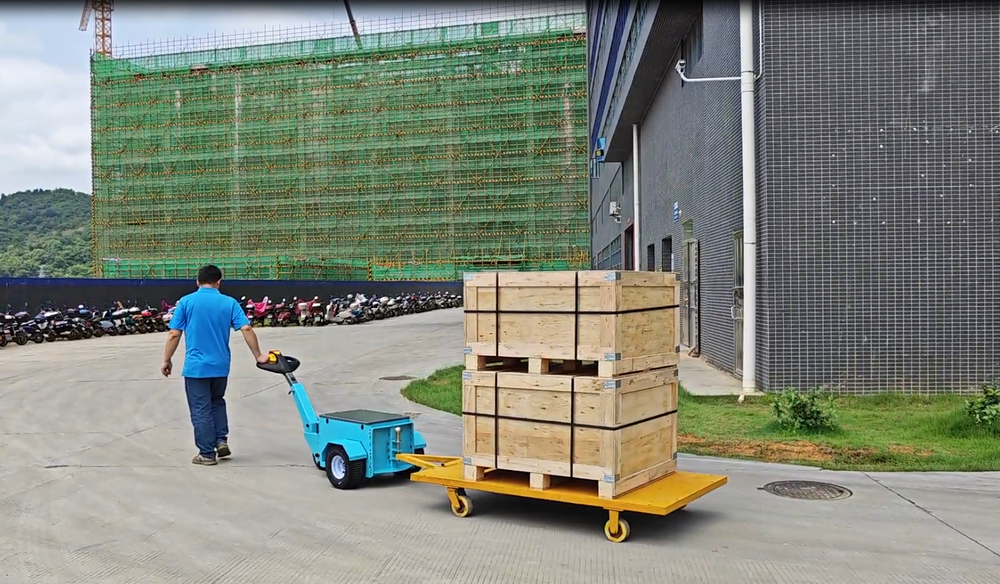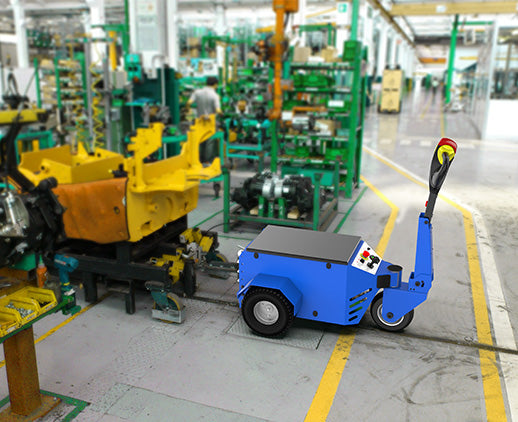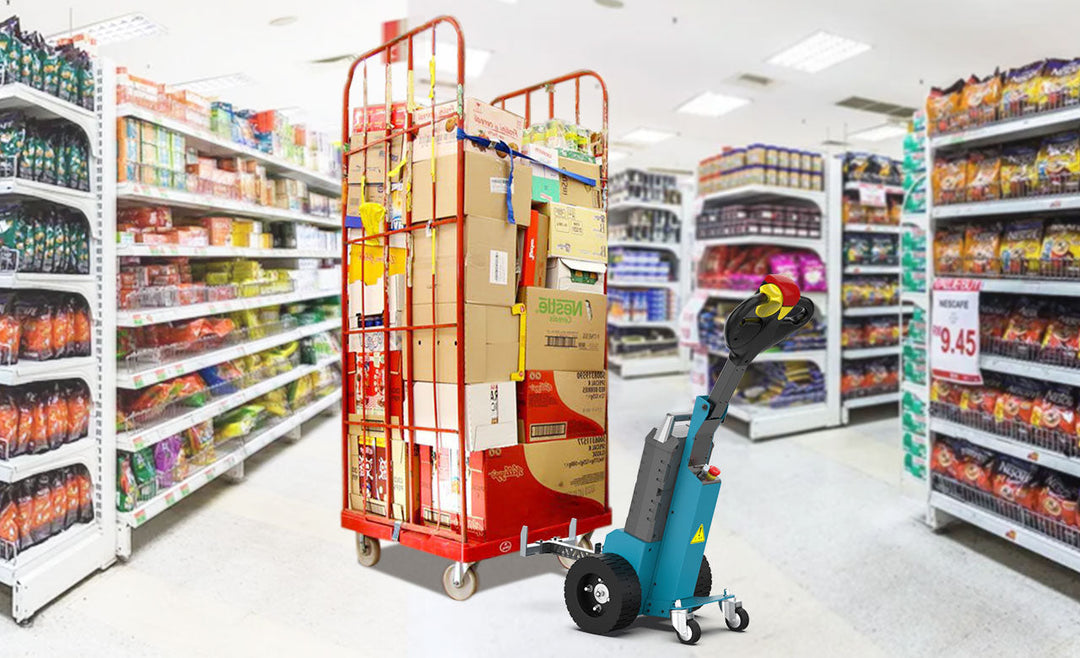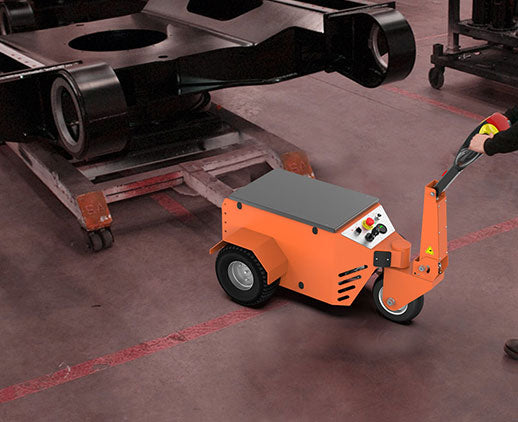What is an Automated Guided Vehicle?Learn All About AGVs in One Article

An Automated Guided Vehicle (AGV) is a kind of robot that carries material within the manufacturing facility or warehouse and uses tracks or markers for navigation. Autonomous Guided Vehicle (AGV)AGVs come with an automatic navigation system and thereby they can move along a predefined path or within an area, without any human interference. They usually operate following markers or wires on the floor, or using vision, lasers, or other 360-degree camera-based systems.
Key features of AGVs
Navigation Systems
Automated Guided Vehicles (AGVs) use different types of navigation technologies to navigate around the plant in an optimal fashion. This has a huge bearing on the AGV's performance and the environments in which it is suitable for use.
Magnetic Strips and Wires
AGVs using magnetic navigation systems follow magnetic strips or wires installed in the facility floor. If the corridors are lined with these strips, the AGVs would have a well-laid path to follow, keeping the chances of deviation at bay. It is one of the most affordable ways to do it, also very easy to install, mainly used in simple applications.
Laser Navigation
laser-guided agv make their own map by using laser scanners. These laser beams are emitted by AGVs and are reflected in turn by the physical markers or items thereby allowing the AGV to determine its position and to navigate its way appropriately. Laser navigation is very versatile and does not require any sort of physical adjustments when the environment changes. For example, in a warehouse, laser-guided AGVs can change their paths on the fly to steer clear of obstacles recently put in place or dynamic work zones.
Camera-Based Systems
While camera-based navigation is a use case for AGVs, computer vision is used to perceive the environment. The environment is analyzed and mapped when a series of cameras capture the images/video which are then processed by state-of-the-art algorithms to direct the AGV. It is works very well in precision areas. The camera-based systems can also read other things, such as barcodes or QR codes for location tracking purposes as we know operational efficiency in the warehouse is so important.
GPS and Advanced Positioning
AGVs are most often controlled by GPS navigation in large outdoor environments. Accurate locations are obtained by high-precision GPS system working either autonomously or together with inertial measurement units (IMUs). This enables AGVs to be used to accomplish complex tasks such as moving materials over long distances in massive factories. A mining site might be served by GPS-guided AGVs carrying minerals over long distances to an accuracy of a few centimeters.
Sensors and Safety
Safety was also a key concern in the operation of AGVs. AGVs use advanced sensor technology to detect and prevent obstructions, which is essential for the safety of both human workers and the vehicles.
Obstacle Detection
AGVs are integrated with a variety of sensors like LIDAR, ultrasonic sensors, and proximity sensors for obstacle detection during their operation. LiDAR sensors create high-resolution 3D maps of the surroundings by using laser light to measure the distances to objects. The technology allows AGVs to determine objects with much accuracy and respond quickly to avoid possibilities for collisions. For example, an AGV in a busy warehouse might sense that a forklift is going to cross its path, and can come to a stop in milliseconds so that an accident does not occur.
Safety Protocols
AGVs Governed By Safety Procedures To Mitigate Risks. The control system of the AGV can also carry out a couple of actions such as come to a standstill, slow down or pass the obstacle to evade it. This preventive method reduces the risk of accidents and a regular supply. Some AGVs are also trained with safety zones or virtual barriers, that they will not move past, so they always remain in a sectioned off area that the AGVs have deemed safe.
Redundancy and Reliability
AGVs are often redundant; an AGV is a path-following robot that follows a path induced by embedded sense sensors, and external sense sensors are added to increment safety. If one drops the ball, the system can keep the vehicle going because the other is still functioning and will take care of the car's navigation and obstacle detection. This redundancy is critical to achieving the levels of safety and operational availability that are now the stated goals of even the most rubbery-kneed regulators and PR departments. For instance, an AGV in an automotive factory might be equipped with LiDAR and ultrasonic rangefinders that provide collision avoidance for very large objects and smaller obstructions, like a tool that is laying on the ground directly in advance.
Human-Machine Interaction
Advanced AGVs are safe to work as sharing the same infrastructure with the human workers They are fitted with both visual and audible alarms to warn personnel in the vicinity. Some even have touch sensitive bumpers that will shut down in case of a collision with an object or person. Such features lead to a safer working environment and improve the collaboration between human-machine.

Types of AGVs
There are many types of Automated Guided Vehicles (AGVs), which are each designed to perform particular tasks in industrial environments. Therefore, it is important to know the various characteristics along with their applications with respect to the AGVs in order to utilize it effectively in manufacturing and warehousing operations.
Tugger AGVs
A set of non-motorized carts selected to be towed behind a Tugger AGV, This kind of AGV would be especially good at moving large amounts of materials over longer distances that are positioned within a single facility — so this could be a warehouse — up to another kind of building.
Traits: Tugger AGVs are known for being almost bomb-proof and able to pull heavy loads, usually exceeding 10,000 pounds. They are designed to drive along pre-programmed routes and can make multiple stops to drop off and pick up carts.
Applications: These AGVs are extensively applied in automotive production lines delivering parts and assemblies between various production lines. They are also located in warehouses and distribution centers, moving items to and from receiving areas and storage zones, and on to shipping docks.
Unit Load AGVs
AGVs that use a unit load concept are designed to move a particular load, such as a pallet or a container. It has mechanisms inside to pick and carry the loads safely.
Features: These AGVs handle different load dimensions and payload capacities, generally from 500 to 5,000 lbs A lift table or a conveyor is typically part of its design for easy loading and unloading.
Applications: Best used in automation warehouses to transfer pallets from the storage racks to the picking areas. In food and beverage industries, they lean containers filled with raw materials or finished products from process areas to packaging areas.
Forklift AGVs
Forklift AGVs—Automated versions of conventional forklifts that lift and move loads to various heights
Specifications: AGVs can lift up to 8,000 pounds and raise the load more than 30 feet. The robots are complemented by sophisticated navigation systems that allow them to safely navigate within confined spaces and around obstacles.
APLICATIONS: These AGV are largely used in high-density storage APPLICATIONSmalaCppCodeGenSumber AutoStore machines can autonomously pick and place pallets on high racking ensuring space utilization for the largest facilities. They transport heavy parts from storage to assembly lines in the manufacturing industry.
Hybrid AGVs
A hybrid AGV usually can be applied to a variety of tasks and requirements, and sometimes includes a cross function of some other AGV types. These allow for versatility in hardware, as these components can be reconfigured to serve different functions as and when needed.
Features: One of the features of hybrid AGVs is that they are multi-function transfer AGVs that can transfer load by towing, lifting, or take as unit load roller pad. They feature modular components that can be adjusted or replaced to accommodate evolving needs.
Applications: These AGV are very useful in the facilities, which have changeable operational conditions. By way of example, a hybrid AGV may be moving raw materials to the production lines in the morning and switching to take completed products to the shipping areas in the afternoon. Not only this, they are also applicable in logistics centers where there are rule changes in the type of goods and handling requirements happen frequently.

Applications of AGVs
In modern industrial operations, Automated Guided Vehicles (AGVs) play a key role. Their automation of material handling tasks leads to increased efficiency in a variety of industries, and with better accuracy and safety too. So, let us know some of the Key applications of AGV in various environments,
Manufacturing
AGVs are important in the manufacturing industry to optimize production processes. Their job is to carry the raw materials, the components and the finished products within the facility.
Automotive Industry: Move car bodies between different assembly stations in automotive assembly plants. An example is where an AGV can transport a car frame from the welding section to the paint booth, which can be accurately timed and reduces manpower work.
Electronics Manufacturing: AGVs move sensitive electronics components between the assembly lines, storage areas etc. This minimizes potential harm to areas that are particularly sensitive. An example would be a AGV carrying semiconductor wafers in a cleanroom that are required to meet specific hygiene requirements.
Warehousing
In the case of a warehouse, AGVs play a very important role in automating the process of storing and retrieving goods, to avoid the inefficiency and inaccuracy associated with manual operations.
Automated Storage and Retrieval Systems (ASRS): In high-density warehouses, AGVs function as part of the ASRS to automatically store and retrieve pallets. There, they weave through tight rows, grab, and then lift something, and then they place it upon an even higher shelf. If a warehouse is making thousands of transactions each day, this type of productivity increase is well worth implementing AGVs.
Order Fulfillment: AGVs help in order picking and packing process. They move products from storage locations to picking bays, where staff builds orders. Warehouses — When thousands of AGVs are working together in a large e-commerce fulfillment center, walking time for workers can be reduced by as much as 70%. Faster order processing through AGVs!
Distribution Centers
AGVs take over the movement of goods from receiving to shipping in warehouses to maintain a smooth flow of goods and make sure products are shipped on time.
Cross-Docking Operations — AGVs can support cross-docking by bringing incoming goods straight to outbound shipping areas, with no long-term storage. In retail distribution centers, where goods like fresh produce need to move quickly, this can be an especially appealing feature.
AGVs for sorting and consolidation For instance, AGVs could optimize moving packages from unloading docks to sorting areas in a vast logistics hub, sorting each one by where it needs to go. This sort of automated process can manage a throughput of thousands of packages per hour, reducing the manual sorting workforce.
Healthcare
AGVs are also gaining popularity in hospitals, thereby improving the levels of productivity and ergonomy.
Hospitals Logistics: In hospitals, AGVs are used as a means to deliver medical supplies, medicines and also meals to different departments. They have pre-programmed routes, guaranteeing a timeline to transport important samples, which eliminates the need for other staff to carry out this task. One example of this is an AGV transporting surgical instruments from a central sterilization unit to the operating rooms.
Pharmaceutical Manufacturing: AGVs help pharmaceutical plants transfer raw materials as well as finished drugs between the stages of production, ensuring rigorous regulatory compliance while minimizing the risks of contamination.
Food and Beverage Industry
AGVs optimise operations within the food and beverage industry, prioritising cleanliness and efficiency.
Material handling: AGVs transport components to production lines and deliver finished goods to packaging areas For example, in a beverage bottling plant, AGVs might first travel to and from the filling machines with pallets of empty bottles and then later transport the filled bottles to a warehouse.
Cold Storage: AGVs also function in cold storage facilities, where human labor is ineffective in lower temperature spaces. They are responsible for the freezing and unfreezing process, managing the supply chain, and using less power.

Benefits of AGVs
AGVs provide a range of advantages across industries, improving operational efficiency, cost and safety. In this piece, we delve into these benefits, supplemented with real examples that demonstrate their implications.
Increased Efficiency
AGVs can run 24/7, without downtime or fatigue, meaning that they can increase productivity tremendously.
Non-Stop Working — As AGVs are machines, they can run 24/7 without getting tired like we humans. Due to the continuous operation, material handling processes are always in operation even after working hours which is resulting in higher throughput.
Example: In an extensive automotive assembly plant, AGVs are utilized to convey parts of cars between the production lines. Running continuously, these AGVs add between 15-20% to the plant's overall throughput by not breeding downtime into the process due to shift changes or breaks.
Cost Savings
The use of AGVs reduces labor costs, and reduces the chance for human error, resulting in major financial savings.
Labor Cost: AGVs automating the handling tasks as a result, the need for manual labor is very limited. This also decreases labor time and expense associated with staffing, training and maintaining a sizable force of residential property inspectors.
Error Minimization: AGV is designed to follow specific routes and process which helps in reducing possibility of errors. This level of accuracy, in turn, reduces the costs associated with errors (e.g. reduced returns, spoilage, incorrect shipments)
Example: AGV automated order fulfillment at a distribution center cut labor costs by 30 percent, reduced shipping errors by 25 percent, and saved over $1 million annually.
Flexibility
The fact that AGVs are easily reprogrammed for new task or route specifications make AGVs highly flexible for dynamic environments.
The reprogramming: AGVs are easy to reconfigure so they can be used to transport different other materials, change layout or amend production times. These are ideally used in industries where requirements differ greatly.
Flexible operations: Fast changing market as basis for operations. AGVs allow for this ability to adapt, meaning that new facility requirements can be met without long periods of downtime.
Use case: An organization that manufactures consumer electronics shifts components between the assembly lines with the aid of AGVs. The AGVS was easily reprogrammed in half a day to manage different parts and be routed through new lines when a new product line was introduced.
Safety
An AGV can automate material handling and minimize risk of accidents with increased safety for workers.
Collision Avoidance: AGVs are often equipped with sensors that allow the robot to recognize objects in its path, stop if necessary or reroute to avoid a collision. This capacity greatly reduces the danger of forklift or manual handling accidents.
Reliable Safety Protocols: AGVs adhere to stringent safety protocols in a reliable manner as opposed to human operators who might skip safety checks. A safe system is provided in each of this consistent manner.
For example, a large pharmaceutical manufacturing facility uses AGVs to transport hazardous materials. This has resulted in a 40% decrease in material handling related workplace accidents, which adds up to increased employee safety due to AGVs' precise control and automated safety features.







